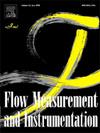尖顶三角堰方形孔洞的阶段-排泄关系
IF 2.3
3区 工程技术
Q2 ENGINEERING, MECHANICAL
引用次数: 0
摘要
本文应用排泄系数 Cd 的经典方法以及尺寸分析的 Π- 定理和自相似性理论,推导了由方形孔洞穿透的尖顶三角堰的阶段排泄方程。首先,利用 Zeinivand 等人(2024 年)的实验数据,验证了这些作者提出的放电系数表达式的适用性。然后,通过尺寸分析,推导出一种新的阶段-放电关系,并利用现有数据集进行了校准。该理论方程的特点是,在 98.9% 的情况下,排量估计误差小于或等于 ±20%,在 87.8% 的情况下,误差小于或等于 ±10%,均方根误差等于 0.00071 立方米/秒。总之,通过尺寸分析推导出的阶段-排量关系的特点是提高了排量估算的性能,同时还具有无需估算排量系数的优点。本文章由计算机程序翻译,如有差异,请以英文原文为准。
The stage-discharge relationship of a sharp-crested triangular weir pierced by square orifices
In this paper, the stage-discharge equation of a sharp-crested triangular weir pierced by square orifices is deduced applying both the classical approach of the discharge coefficient Cd and the Π- Theorem of dimensional analysis and the self-similarity theory. At first, using the experimental data by Zeinivand et al. (2024), the applicability of the expression of the discharge coefficient proposed by these authors was verified. Then, applying the dimensional analysis, a new stage-discharge relationship was deduced and calibrated using the available dataset. This theoretical equation is characterized by errors in the discharge estimate that are less than or equal to ±20 % for 98.9 % of cases and ≤ ±10 % for 87.8 % of cases, and the root mean square error is equal to 0.00071 m3 s−1. In conclusion, the stage-discharge relationship deduced by dimensional analysis is characterized by an improvement in the performances in the discharge estimate and also has the advantage of working without the need of estimating the discharge coefficient.
求助全文
通过发布文献求助,成功后即可免费获取论文全文。
去求助
来源期刊

Flow Measurement and Instrumentation
工程技术-工程:机械
CiteScore
4.30
自引率
13.60%
发文量
123
审稿时长
6 months
期刊介绍:
Flow Measurement and Instrumentation is dedicated to disseminating the latest research results on all aspects of flow measurement, in both closed conduits and open channels. The design of flow measurement systems involves a wide variety of multidisciplinary activities including modelling the flow sensor, the fluid flow and the sensor/fluid interactions through the use of computation techniques; the development of advanced transducer systems and their associated signal processing and the laboratory and field assessment of the overall system under ideal and disturbed conditions.
FMI is the essential forum for critical information exchange, and contributions are particularly encouraged in the following areas of interest:
Modelling: the application of mathematical and computational modelling to the interaction of fluid dynamics with flowmeters, including flowmeter behaviour, improved flowmeter design and installation problems. Application of CAD/CAE techniques to flowmeter modelling are eligible.
Design and development: the detailed design of the flowmeter head and/or signal processing aspects of novel flowmeters. Emphasis is given to papers identifying new sensor configurations, multisensor flow measurement systems, non-intrusive flow metering techniques and the application of microelectronic techniques in smart or intelligent systems.
Calibration techniques: including descriptions of new or existing calibration facilities and techniques, calibration data from different flowmeter types, and calibration intercomparison data from different laboratories.
Installation effect data: dealing with the effects of non-ideal flow conditions on flowmeters. Papers combining a theoretical understanding of flowmeter behaviour with experimental work are particularly welcome.
 求助内容:
求助内容: 应助结果提醒方式:
应助结果提醒方式:


